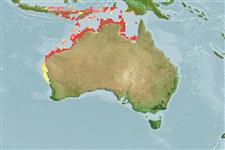>
Eupercaria/misc (Various families in series Eupercaria) >
Nemipteridae (Threadfin breams, Whiptail breams)
Etymology: Scaevius: Latin, scaeva = the wrong way, clumsy.
Environment: milieu / climate zone / depth range / distribution range
पारिस्थितिकी
समुद्री प्रवाल-भित्ति संयुक्त; गहराई सीमा 1 - 20 m (Ref. 9785). Tropical; 7°S - 30°S, 109°E - 141°E (Ref. 3810)
Western Pacific: northwestern Australia from Gulf of Carpentaria to Abrolhos Islands. Also known from Papua New Guinea (Ref. 6192). This species has been commonly referred to as Scaevius nicanor Whitley, but Scaevius milii is the older name.
आकार / वज़न / Age
Maturity: Lm ? range ? - ? cm
Max length : 20.0 cm SL पुल्लिंग / अलिंग; (Ref. 3810); common length : 15.0 cm SL पुल्लिंग / अलिंग; (Ref. 3810)
पृष्ठीय रीढ़ (सम्पूर्ण) : 10; पृष्ठीय सौफट रेज़ (सम्पूर्ण) : 9; गुदा कांटा: 3; ऐनल सौफट रेज़: 7. Scales on top of head not reaching to level of eyes. Snout, suborbital, interorbital, and temporal parts of head naked. Posterior margin of suborbital denticulate, a small spine in upper corner. 5 or 6 transverse rows of cheek scales. Preopercle serrate, opercle scaly. Lower limb of preopercle naked. Upper margin of opercle with a small, flat, rounded spine. Pectoral fins short, not reaching to level of anus. Pelvic fins long, reaching to level of anus. Color: Dark olive on top of head, back paler, ventral surface white. 2 blue stripes on snout, the first joining eyes through nostrils, the second across front of snout. 2 narrow blue lines below eye crossing suborbital.
Abundant on shallow inshore reefs and adjacent sand or mud bottoms. Feeds on small fishes and benthic invertebrates. Unimportant as a food fish. No major fishery exists.
Life cycle and mating behavior
Maturities | पुनरुत्पत्ति | Spawnings | Egg(s) | Fecundities | लार्वा
Russell, B.C., 1990. FAO Species Catalogue. Vol. 12. Nemipterid fishes of the world. (Threadfin breams, whiptail breams, monocle breams, dwarf monocle breams, and coral breams). Family Nemipteridae. An annotated and illustrated catalogue of nemipterid species known to date. FAO Fish. Synop. 125(12):149p. Rome: FAO. (Ref. 3810)
IUCN Red List Status (Ref. 130435)
Threat to humans
Harmless
Human uses
मात्स्यिकी: लघु वाणिज्य
साधन
Special reports
Download XML
इंटरनेट स्रोत
Estimates based on models
Preferred temperature (Ref.
123201): 26.7 - 28.7, mean 28.3 °C (based on 282 cells).
Phylogenetic diversity index (Ref.
82804): PD
50 = 1.0000 [Uniqueness, from 0.5 = low to 2.0 = high].
Bayesian length-weight: a=0.01479 (0.00706 - 0.03101), b=2.97 (2.80 - 3.14), in cm total length, based on LWR estimates for this (Sub)family-body shape (Ref.
93245).
Trophic level (Ref.
69278): 4.0 ±0.63 se; based on food items.
लौटाव (Ref.
120179): ऊंचा, न्यूनतम जनसंख्या दुगनी समय अवलागत 15 महीने। (Preliminary K or Fecundity.).
Fishing Vulnerability (Ref.
59153): Low vulnerability (14 of 100).
Nutrients (Ref.
124155): Calcium = 70 [43, 149] mg/100g; Iron = 0.684 [0.321, 1.703] mg/100g; Protein = 19.2 [17.3, 20.9] %; Omega3 = 0.155 [0.090, 0.265] g/100g; Selenium = 22.6 [12.4, 42.8] μg/100g; VitaminA = 100 [27, 309] μg/100g; Zinc = 1.31 [0.88, 1.93] mg/100g (wet weight);
